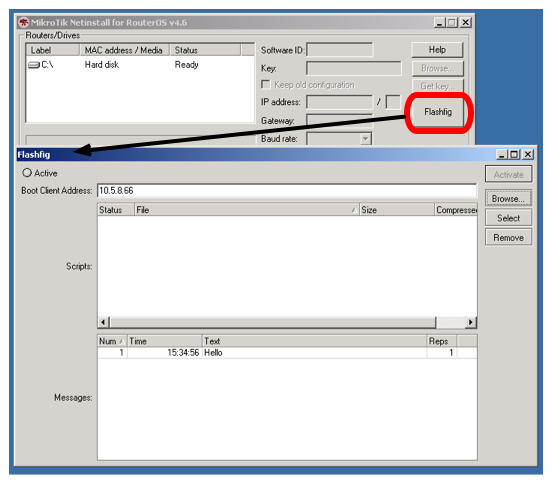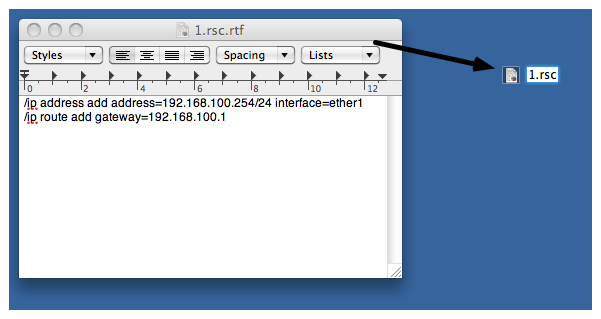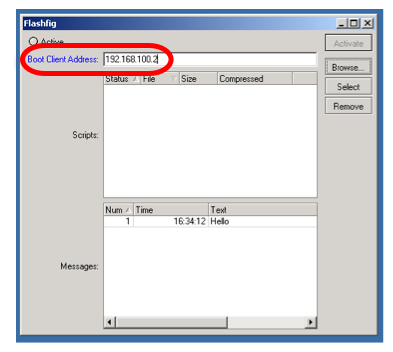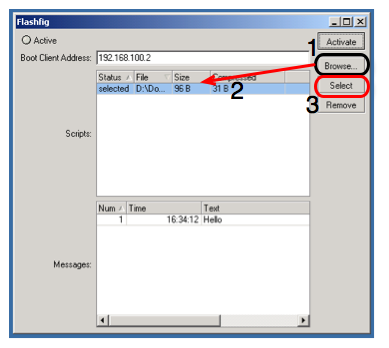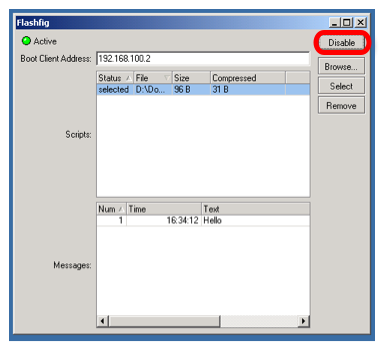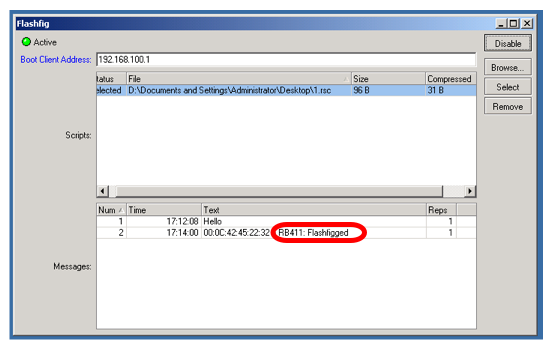Manual:Flashfig: Difference between revisions
→Run Flashfig: Fix image |
→Run Flashfig: Fix |
||
| Line 91: | Line 91: | ||
[[File:Flashfig6.png]] | [[File:Flashfig6.png]] | ||
Log | Log shows "RouterBOARD Flashfigged" and RouterBOARD should make sound/LED signal, now it is safe to unplug the router. | ||
* Flashig | * Flashig '''configuration''' was applied to the RouterBOARD and it is '''ready''' to be used in production. | ||
[[Category:Manual]] | [[Category:Manual]] | ||
[[Category:Routerboard]] | [[Category:Routerboard]] | ||
Revision as of 16:11, 22 February 2010
Description
Flashfig is an application for mass router configuration. It can be used by MikroTik distributors, ISPs or any other companies who need to apply RouterOS configuration to many routers in shortest possible time.
Flashfig applies MikroTik RouterOS configuration to any RouterBOARD within 3 seconds. You can "flashfig" batch of routers, the only thing you need - connect RouterBOARD to network and power it.
Flashfig runs on a Windows computer, Flashfig is available within Netinstall.
Flashfig is supported by all RouterBOARDs. It works between computer with Flashfig and RouterBOARD in the same broadcast domain (direct Ethernet network connection is required).
Flashfig support is enabled on every new RouterBOARD by default from factory (RouterBOARDs manufactured after March 2010). For older models, Flashfig can be enabled via RouterBOOT or from MikroTik RouterOS console.
After Flashfig is used once on a brand new RouterBOARD, it is disabled to avoid unwanted reconfiguation at later time. To use Flashfig a second time on the same router, you need to enable it in Bootloader settings.
If RouterOS reset-configuration command is used later, Flashfig applied configuration is reloaded by default.
Flashfig Example
This is a step by step example of how to use Flashfig to set typical MikroTik RouterOS configuration to RouterBOARD.
Introduction
Flashfig is available from Netinstall,
Requirements
The Windows computer must be equipped with the following ports and contain the following files:
- Ethernet port;
- The .rsc file(s) with MikroTik RouterOS configuration (the same as export/import file);
- The latest NetInstall/Flashfig program available from the downloads page;
The RouterBOARD:
- Flashfig is supported by first boot of RouterBOARD;
Pre-Configuration
Windows Computer
- Run Flashfig;
- Prepare .rsc file, .rsc file is regular/import file, it accepts valid MikroTik RouterOS CLI commands. You can create .rsc file by any text-editor program (Notepad, Texteditor, TextEdit, Microsoft Word, OpenOffice Writer);
- Assign Boot Client Address, which should be address from the same subnet as configured on laptop Ethernet interface,
- Browse for .rsc MikroTik RouterOS configuration file to apply to RouterBOARD, highlight the file and Select to approve it,
- Activate Flashfig server, now it is ready to Flashfig. Note, any RouterBOARD will be flashfiged within the network, which is powered on with boot-device configured to flash-boot or flash-boot-once-then-nand,
RouterBOARD
- Flashfig mode is enabled on every RouterBOARD from factory by default, which means no configuration is required on RouterBOARD.
- If Flashfig is not enabled on your router, access the RouterBOARD with Winbox/Console and set the configuration,
/system routerboard settings set boot-device=flash-boot
or use more preferable option,
/system routerboard settigs set boot-device=flash-boot-once-then-nand
Your router is now ready for Flashfig.
Connect
Connect RouterBOARD and Flashfig computer to the same Local Area Network.
Run Flashfig
- Plug power for RouterBOARD
- Check the status on Flashfig program,
Log shows "RouterBOARD Flashfigged" and RouterBOARD should make sound/LED signal, now it is safe to unplug the router.
- Flashig configuration was applied to the RouterBOARD and it is ready to be used in production.

